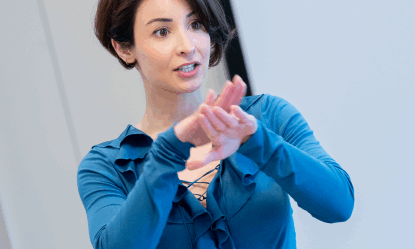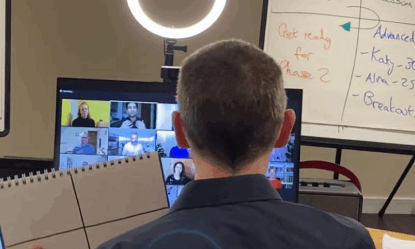“The human brain evolved through social interactions, which is why it is so stimulated by face-to-face contact.“
Face-to-Face Communication – Why It’s Better For Our Brains
If you’ve ever left a virtual call feeling confused, frustrated, or that your message just hasn’t landed the way you wanted it to, it may be less about the technology and more about your own biology!
At Body Talk, we believe powerful communication starts with science and understanding how the brain responds. In this blog, we explore the brain-based benefits of face-to-face communication – and why it still matters in the digital age we live in.
Why is face-to-face communication important in business?
A recent study has shown that using technology to communicate online is less effective than face-to-face conversations, as it doesn’t engage the brain in the same way.
The study, published in the journal NeuroImage, measured the effect of technology-assisted communication on mothers and their teenage children. During the experiment, participants’ brain activity was monitored during rest, face-to-face conversations and virtual calls.
The researchers measured electrical activity in the brain during each type of communication and discovered that participants’ brains ‘synchronised’ when they were face-to-face in a way that did not occur during virtual communication.
To put it another way, face-to-face activity allowed the participants to ‘tune in’ to one another much more effectively. This deeper connection is one of the key reasons strong communication plays such an important role in business. You can explore this further in our guide on why communication is important.
In fact, during live interactions, nine ‘cross-brain links’ were developed between the participants, compared to just one link on a virtual call.
What are the advantages of face-to-face communication?
So what is it about face-to-face interactions that fires up our brain so much – and what is missing when we’re online?
In-person communication allows interactions that virtual does not
The human brain evolved through social interactions, which is why it is so stimulated by face-to-face contact compared to other forms of communication. Experts think that being in the same room as someone allows increased opportunities for experiences such as a shared gaze, social engagement and empathic resonance, which leads to better communication and understanding.
Non-verbal communication comes through stronger face-to-face
On the flip side, virtual interactions appear to eliminate the brain activity that is linked to our processing of non-verbal social cues and affective states of the other person.
In short, our brains aren’t as good as ‘reading’ people when conversing online. It’s more difficult for us to understand people’s intentions and to read their emotional state. If you find virtual calls tough, it’s not you – it’s your brain!
Face-to-face meetings avoid Zoom fatigue
The reduction in communication ability when meeting virtually could be a key contributor to what is most often referred to as ‘Zoom fatigue’.
There are a number of elements that make it difficult to concentrate or pay attention on virtual meetings, whether Zoom, Google Meet, Microsoft Teams or another platform. These include the constant screen gazing during video chats, which we haven’t evolved to do, reduced mobility, ‘mirror anxiety’ from looking at ourselves for long periods and awkward delays in response time due to muting microphones or talking over one another.
Bad posture or camera angles also make it very difficult to read non-verbal cues, such as body language and facial expressions, which happen naturally during face-to-face conversation.
Should my meeting be in-person or a video call?
We’re faced with a lot of choices these days about how we run our meetings and presentations, so it can be difficult to weigh up the pros and cons and work out what’s right for us.
While technology allows us greater freedom and ability to connect instantly with teams across the world, a face-to-face meeting is the optimal way of communicating. Why? It allows you and the other participants to engage fully with one another, taking in the non-verbal cues and reading emotions and intentions more easily.
That said, virtual communication still holds a very important place in our day-to-day lives, especially for those working remotely. The good news is that even though it was less effective than in-person communication, the study still found that brains were able to synchronise via screens.
How to communicate effectively online
A key factor in improving virtual communication is to try and replicate the authenticity of a face-to-face meeting wherever you can.
This includes:
- Setting up your camera so that the other person can see your upper body and hands. This is essential so that you can use your body language, particularly your gestures, to help give those non-verbal cues that are typically lacking in online meetings. We have more tips on how to set up your camera here.
- Making your meetings shorter. The exhaustion that comes with virtual communication means that participants aren’t able to concentrate for the same amount of time as they would in a face-to-face meeting. Send out an agenda or reading material beforehand so that people have the key information already, and keep your actual meeting as concise as possible.
- Explain the logistics at the outset, including how and when people will be invited to speak. Part of the stress involved in virtual calls is linked to awkwardness with people talking over one another, so get someone to facilitate the meeting and choose who will speak when.
Ultimately, understanding how our brains process information during different types of meetings will help you to choose what’s best for your team. Whilst a virtual call may be convenient, you might find that a 15-minute in-person meeting could actually be more effective than a one-hour online meeting.
Take your face-to-face and digital communication skills further with Body Talk
At Body Talk, we run courses and masterclasses on communication skills to help you get the best out of every interaction – whether you’re communicating face to face or through digital platforms.
Get in touch today to find out how we could help your team. Or watch/listen to our podcast with BBC Presenter Alina Jenkins about how to communicate with impact in a virtual setting.
Frequently asked questions
Answers to your questions on face-to-face communication.
What are some tips for improving face-to-face communication?
To communicate face-to-face with more impact:
- Make intentional eye contact. It signals confidence and shows you’re present.
- Be aware of your body language. It speaks volumes before you even say a word.
- Practice active listening. Show you’re truly engaged. As a team leader especially, it sets the tone for collaboration and respect.
- Consider communication skills training. Working with one of our expert coaches gives you clarity on where to focus, confidence in how to grow, and the personalised tools to help you thrive.
What are some examples of face-to-face communication?
Here are a few examples of how you can swap digital or written communication for more meaningful face-to-face communication:
- Instead of sending feedback by email, offer it in person. That personal touch helps your message land with clarity and care.
- Replace long message threads with quick team meetings to align, problem-solve, and move forward together.
- Skip the screen when working through challenges. Tackling an issue face to face brings faster, more collaborative problem solving.
How does face-to-face communication build trust?
Face-to-face communication adds nuance that’s often lost in digital or written communication. Your tone of voice, facial expressions and body language provide essential context, reducing the risk of misunderstandings. That clarity makes it easier to handle a difficult conversation without losing trust.
It also encourages active participation. When people are physically present, they tend to engage more deeply, ask better questions, and listen more attentively, all vital ingredients in building relationships that last.
In fact, the Freeman Trust Report 2023 found a strong link between in-person interactions at live events and increased trust. Whether you’re presenting to clients or aligning with your team, communicating face-to-face creates stronger relationships through real connection and shared presence. Improving your presentation skills, could help you build connections smoother and faster.

















